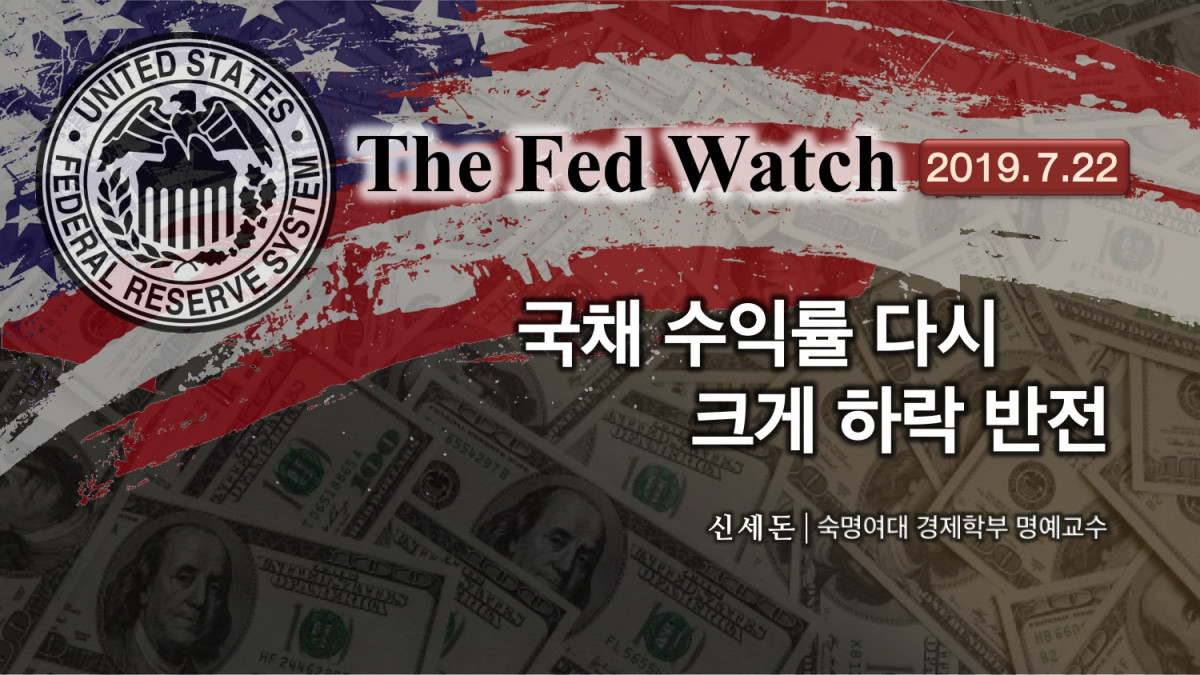국가미래연구원은 폭 넓은 주제를 깊은 통찰력으로 다룹니다
※ 여기에 실린 글은 필자 개인의 의견이며 국가미래연구원(IFS)의 공식입장과는 차이가 있을 수 있습니다.
[FED Watch] 국채 수익률 다시 크게 하락 반전 - 2019.7.22 본문듣기
작성시간
- 기사입력 2019년07월21일 17시00분
- 최종수정 2019년07월20일 15시25분
관련링크
본문
<1> 금주의 T-Bill Yield Curve : 국채수익률 전반적 하락세
■ 지난 주(7/12-7/18일) 국채수익률은 전체적으로 비교적 큰 폭 상승.
- 1월, 3월, 및 6월 물은 각각 6bp, 12bp와 7bp 하락
- 중, 장기물은 7bp-10bp 하락.
■ 2주전(7월 3일)과 비교하면 단기물은 10bp 낮은 반면에
중장기물은 오히려 10bp 내외 더 높은 수준
- 수익률곡선 기울기가 다소 증가함 : 장기 인플레 심리가 다소 살아나는 증거
■ 5년 만기물 수익률의 경우 주중 상승하다가 7월 17일 이후 급락하여 1.78% 기록
<2> 2019년 6월 FOMC-연준 연석회의 의사록 (2019년 7월 16일 공개)
■ MONETARY POLICY IMPLEMENTATION - Interest rate on reserve balances unchanged; - rates on discounts and advances unchanged; - renewal of secondary and seasonal credit formulas. |
In a joint meeting of the Federal Open Market Committee (FOMC) and the Board today, the FOMC decided to maintain the target range for the federal funds rate at 2.25 to 2.50 percent. Consistent with the FOMC's decision to leave the target range for the federal funds rate unchanged, the Board approved maintaining the existing interest rates (2.35 percent) paid on required and excess reserve balances. At today's meeting, the Board also approved the establishment of the interest rate on discounts and advances made under the primary credit program (the primary credit rate) at the existing level (3 percent).
Subject to review and determination by the Board of Governors, the directors of the Federal Reserve Banks of Boston, Philadelphia, Richmond, and Minneapolis had voted on June 6, 2019, and the directors of the Federal Reserve Banks of New York, Cleveland, Atlanta, Chicago, Kansas City, Dallas, and San Francisco had voted on June 13, to establish the primary credit rate at the existing level of 3 percent.
The directors of the Federal Reserve Bank of St. Louis had voted on June 6 to establish a primary credit rate of 2.75 percent (a decrease from 3 percent).
Overall, Federal Reserve Bank directors remained positive about economic conditions, although many expected the rate of economic growth to be somewhat slower than in 2018. Several directors reported continued strength in consumer spending. Activity in residential real estate was mixed across Districts. Labor market conditions remained strong, with employers in many Districts attracting workers through both wage and non-wage incentives, including stronger benefits packages and training programs. In some Districts, employers were also hiring nontraditional workers. Directors' reports on manufacturing activity varied, and some directors noted rising input costs. Most directors cited heightened trade tensions and the associated uncertainty as risks to the U.S. economic outlook.
Against this backdrop, the directors of all but one Federal Reserve Bank favored maintaining the current primary credit rate at the existing level (3 percent). These directors judged that it would be appropriate for the FOMC to closely monitor the implications of incoming information for the economic outlook and act as appropriate to sustain the expansion, with a strong labor market and inflation near its symmetric 2 percent objective.
However, other Reserve Bank directors recommended a decrease in the primary credit rate (to 2.75 percent), given current and anticipated economic conditions.
No sentiment was expressed by the Board at today's meeting for changing the primary credit rate at this time, and the Board approved the establishment of the primary credit rate at the existing level of 3 percent. (NOTE: At the joint Board-FOMC meeting on May 1, 2019, the Board had approved the establishment of the primary credit rate at 3 percent.)
The Board's action today on the primary credit rate also included renewal of the existing formulas for calculating the rates applicable to discounts and advances under the secondary and seasonal credit programs. As specified by the formula for the secondary credit rate, this rate would be set 50 basis points above the primary credit rate. As specified by the formula for the seasonal credit rate, this rate would be reset every two weeks as the average of the daily effective federal funds rate and the rate on three-month CDs over the previous 14 days, rounded to the nearest 5 basis points.
■ Voting for these actions: Powell, Clarida, Quarles, Brainard and Bowman.
<3> 제9지역 미니애폴리스 연방은행 총재 닐 카시카리(1973 - )
닐 카시카리(Neel Kashkari)는 2016년 1월 1일부터 미니애폴리스 연방은행의 13대 총재로 부임했으며 2019년에는FOMC의 의결권 가진 위원이 되었다.
1973년 7월 30일 오하이오에서 출생했다. 그의 어머니 셰일라 카시카리는 애크런 시립병원의 병리학자이고 아버지 샤먼 카시카리는 애크런대학교의 전기공학교수이다. 양친은 모두 캐시미르지역 지역의 힌두교도였으며 1964년 미국으로 이민 와서 오하이오 주에 정착하였다. 1995 기계공학 학사, 1998년 기계공학 석사학위를 일리노이대학교-어바나 샴페인에서 받았다. 그리고 곧바로 캘리포니어 리돈도 비치에 있는 TRW라는 회사에 항공엔지니어로 입사했다.
일 년 정도 TRW를 다니던 카시카리는 2000년 워튼스쿨 MBA 프로그램에 등록하여 2년 뒤 졸업하였으며 학기 여름방학 중에는 골드먼 삭스에 인턴으로 근무했다. 2002년 학교를 졸업한 뒤 곧바로 골드먼 삭스 샌프란시스코지사에서 IT 관련 금융업무를 관장하게 되었고 부사장까지 승진했다. 당시 골드먼 삭스의 사장인 폴슨이 2006년 미국 재무부장관으로 옮겨 가면서 같이 재무부에 들어간 카시카리는 한 때 폴슨 장관의 보좌관으로 있다가 2008년 서브 프라임 위기 당시 부시대통령에 의해 금융안정청 담당 부장관직으로 임명되었다.
2009년 금융위기를 수습하는 프로그램이었던 TARP를 관장하고난 뒤 재무부를 나온 카시카리는 PIMCO라는 회사에 사장으로 자리를 옮겨 캘리포니어 주지사 선거에 출마하기 위해 2013년 퇴사하기 까지 4년 동안 근무했다.
2014년 캘리포니어 주지사 선거에서 낙선한 카시카리는 2015년 11월 미니애폴리스 연방은행 이사회에서 총재로 추대되었고 연준 이사회에서 5 : 0 으로 추인되어 2016년 1월 1일 부임하였다. 이로써 당시 연방은행 총재에는 네 명의 골드먼 삭스 출신이 자리하게 되었다(카시카리 외에 뉴욕의 더들리, 댈러스의 카플란, 필라델피아의 하커) <ifsPOST>
- 기사입력 2019년07월21일 17시00분
- 최종수정 2019년07월20일 15시25분
댓글목록
등록된 댓글이 없습니다.

